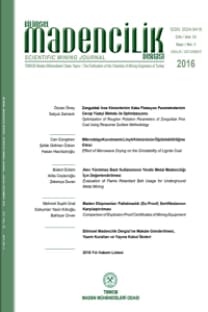YÜKSEK FIRIN ŞARJI
Daha büyük yüksek fırınlara doğru temayül, fırına nakledilen hammaddelerin miktar olarak pek çok artması ve bir nisbet dahilinde yüzde olarak tolerans bırakılan hataların azaltılmasını temin sebebi otomatik şarj kontrolünü elzem kılmıştır. Maden cevherlerinin pellet'lerin, zinterler'in ve eritici maddelerin (Flux) geniş çaptaki seçiminden hasıl olan pratik sahadaki tekamül kapasitesini tahakkuk ettirmek için lüzumlu işi yapan kontrol cihazlarının sayısı pek çok artmıştır. Aynı zamanda, senelerce devaımlı olarak çalışan fırınlarda, otomatik şarj sistemi son derece güvenilir bir hale gelmiştir. Elektronik anahtarla kontrol cihazları ideal bir şekilde bu sahaya tatbik edilmiştir Bu yazıda, ham maddelerin bir nisbet dahilinde ve sürekli bir şekilde ımuamelesiyle ilgili problemler ve metodlar incelenmiş tir. Bu gün ham maddeleri fırının üstüne taşımak için kullanılan iki usul; skip veya konveyörlerle, bunların çalıştırılma prensipleri beraberce incelenmektedir. Sistemin başından sonuna kadar olan çalışıma sırası basılmış şeritler veya elle hazırlanmış devreler vasıtasiyle kompütörde programlanabilir. Böyle bir sistem, malûmat toplayıcılar vasıtasiyle bir arada toplanan performans kayıtlariyle beraber, elektronik beyinler vasıtasiyle fırının gelecekteki çalışma faaliyetlerinin daha iyi bir şekilde düzenlenmesi için esas teş kil eder.
The trend towards larger blast furnaces has made automatic chargig control necessary because of the greatly increased volume of raw materials to be transported and the reduction of the tolerable percentage error in proportioning. To realise the potential improvements in operating practice which result from a greater selection of ores, pellets, sinters and fluxes, the number of control devices performing the necessary logic has become very large. At the same time, with furnaces operating continuously for several years, the automatic charging system must be extremely reliable. Electronic switching control equipment is ideally suited o this application. The methods and problems involved in both continuous and batch proportioning hoists or conveyors are usual today, adn the drive requirements for both are examined. The overall sequence of operations may be programmed by plugs on patchboard matrices or by punched tape. Such charging systems, together with performance records complied by a data logger, form the basis for future direction of the furnace operations by a digital computer.
- ISSN: 2564-7024
- Yayın Aralığı: Yılda 4 Sayı
- Yayıncı: TMMOB Maden Mühendisleri Odası
Sayıdaki Diğer Makaleler
DÜŞÜK TENÖRLÜ FLUORİT CEVHERİNİN ZENGİNLEŞTİRİLMESİ
İŞLETMELERDE MODERN SEVK VE İDARE
ARŞİMET SPİRALİ ŞEKLİNDE TERTİPLENMİŞ ELEKTROMANYETİK VERİCİ
CEVHER ZENGİNLEŞTİRME HAKKINDA ANA BİLGİLER
KUZEY BATI ANADOLU BİTÜMLÜ ŞİST YATAKLARI
DOWEX A—1 CHELAT REÇİNESİ DENİLEN KATYON DEĞİŞTİRİCİSİ İLE ÇİNKO ELEKTORİTLERİNİN HASSAS TEMİZLENİŞİ
